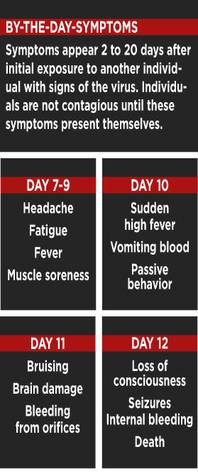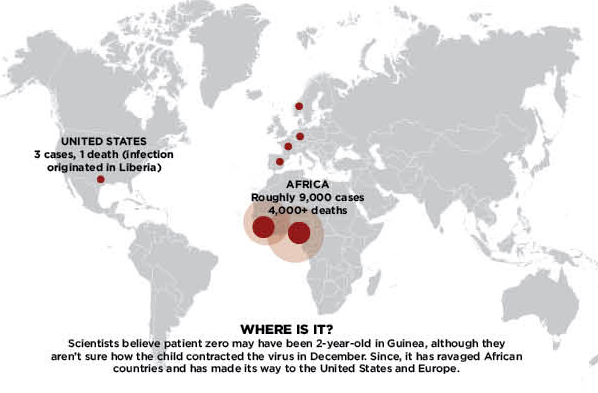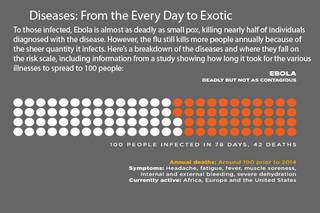
Brynn Anderson / AP
Licensed clinician Hala Fawal practices drawing blood from a patient using a dummy Monday, Oct. 6, 2014, in Anniston, Ala. The Centers for Disease Control and Prevention has developed an introductory training course for licensed clinicians.
Monday, Oct. 20, 2014 | 2 a.m.
How it spreads
Ebola is considered extremely infectious but not extremely contagious. A tiny amount can make someone fatally ill but it is not spread through the air as most highly contagious diseases are. It’s transmitted through:• Blood
• Urine
• Saliva
• Sweat
• Feces
• Vomit
• Semen
• Breast milk
• Dirty needles or syringes
They fly into McCarran International Airport with their credit cards, their luggage and their plans to enjoy the type of fun only Las Vegas can offer.
But with them arrives a risk to us — invisible, yet potentially just as dangerous as the weapons that the airport security system is designed to detect.
The threat is an outbreak of contagious disease like Ebola, and Las Vegas is more vulnerable to it than most other communities.
Why? The answer lies in the middle word of our airport’s title. Although infectious diseases have largely been controlled in the United States through vaccinations and treatment, they’re often brought into the country from other nations, using airports as their steppingstones. And our airport is the 25th-busiest in the world.
The city also offers an environment prone to the spread of disease, with tens of thousands of people mingling in public spaces. They sit shoulder to shoulder at table games, and they touch the same gaming machines, cards and dice.
In a town whose economic lifeline is those same 40 million annual tourists who also present the risk of spreading the disease, the effects of an outbreak would be devastating. That fact isn’t lost on health and public safety officials, who have built an elaborate system to protect the community from pathogens.
“I firmly believe we are as prepared, if not more prepared, than any jurisdiction our size or larger,” said Dr. Joe Iser, chief health officer for the Southern Nevada Health District.
The fabric of the protective network is a vast team of health care providers, public health officials, first responders, government authorities and airline staff. Using special equipment, training, protocols and procedures, their jobs are to detect, isolate and contain any threat.
As shown during recent events in Dallas, protocols can evolve when officials must contend with reports of disease. That’s also been the case in Las Vegas, where the region’s preparedness was tested this month when an infant who had recently traveled to Africa with his mother vomited on a Delta airliner at McCarran.
“We had been going through tabletop exercises at the airport to prepare for the possibility of Ebola showing up here, but that incident was for real and the system got tested,” said Dr. Dale Carrison, UMC’s chief of staff and chair of its emergency medicine department. “And we discovered holes in our system.”

If You Think You’ve Been Infected
Officials urge you not to panic, because you may not have the disease. Some symptoms of Ebola, including fever and a sore throat, are related to other illnesses. If you do have the disease, going to an emergency room could expose others to the illness.
STEP ONE Call your physician.
STEP TWO If you know you have been exposed to the disease, notify the Southern Nevada Health District at 702-759-1000.
STEP THREE If you have traveled to West Africa recently, you should notify the Health District even if you are not having any symptoms.
Firefighters sprang into action, boarding the plane wearing face masks, goggles and gloves designed to protect against Ebola. County health officials were summoned. The plane was quarantined for 90 minutes. The Centers for Disease Control and Prevention was notified.
The situation turned out to be nothing more than a scare, as it was determined that the child and mother weren’t a health risk. Among the factors that went into the determination: Health
officials gleaned that the two hadn’t traveled to any of the West African countries that have become danger zones for the virus.
Jeff Buchanan, Clark County Fire Department deputy fire chief, said everyone involved followed protocols to the letter. Those begin with the flight crew alerting the pilot, who in turn calls the tower. Tower personnel call in a fire alarm, and firefighters ask questions to determine whether the passenger poses a risk for Ebola. If so, firefighters go aboard, assess the situation and notify the health department and CDC.
“They (health officials) will make a determination of whether there is a risk or not — whether the person needs to be quarantined or can be let go,” Buchanan said.
Christine Crews, spokeswoman for McCarran, said airport officials are instructed to err on the side of caution.
“Once we’re notified there’s a potentially contagious disease on an aircraft, we will quarantine that aircraft,” she said. “It’s the best way to contain all the passengers. Once the aircraft is in a secure location, we turn it over to first responders.”
While local health officials work with the CDC in assessing the situation, hospitals are available with isolation rooms in case patients need to be transported. There are 32 such rooms at UMC and 70 at Sunrise Hospital and Medical Center, to give a couple of examples, and other hospitals in the valley have similar facilities. Hospitals also all feature negative pressure rooms, where the air pressure is lower than it is outside so that no air can escape and carry pathogens with it.
In this case, the infant was taken to an isolation room at UMC — and, Carrison said, lessons were quickly learned.
“We realized we needed a way for people outside the room to communicate with those inside the room, without having to open the door each time. So we’re now putting in a radio system. And the CDC was coming out with rules about how to dock and undock when caring for patients — putting on and taking off the personal protection equipment. Taking it off is harder because there’s greater chance for the caregiver to be contaminated. So we’ve been working on that, too.”
Should another Ebola report arise from McCarran, any ailing passengers who have traveled to a West African hot spot would be isolated. But others who were merely exposed to those passengers would be asked to self-quarantine for 21 days and see a doctor if a fever develops.
“We work through the CDC to make sure the person hasn’t come in from a country of origin,” Iser said. “If the ill person has not been to one of the three countries and is arriving from Norway, for instance, we would have no worries.”

Ninety-five percent of people traveling out of West Africa arrive in the United States at one of five airports: New York’s JFK, Newark, Washington Dulles, Chicago O’Hare and Hartsfield-Jackson in Atlanta. For that reason, temperature screenings to help detect Ebola virus-carrying passengers from Liberia, Sierra Leone and Guinea are being conducted at those airports.
But Carrison said efforts to screen out Ebola virus-carrying passengers are not foolproof, and that it is possible for such a person to fly into the country, not yet show any symptoms at the first airport and continue flying to Las Vegas before falling sick. “A person may not self-report that he was in contact with an Ebola victim, show no fever, arrive in Las Vegas, go downtown, start showing symptoms but still have sex with an outcall dancer, who in turn may have sex with others in the next few days, putting all of them at risk. Yes, it’s a possible scenario. It could happen.
“But I’m a lot more worried about people in Las Vegas having latent tuberculosis or hepatitis C and not knowing it, and spreading it and eventually dying of it — maybe not in a few days but five or 10 years from now. Malaria will kill 625,000 people worldwide this year. The CDC expects between 20,000 and 30,000 people will die this year in the United States from the flu. These diseases are more contagious than Ebola. We have lots of other diseases that are of greater risk to us.”
Concerns over McCarran being a conduit for pathogens existed long before Ebola began making headlines. Las Vegas’ protective system underwent a test in 2003, when the Asian SARS outbreak hit home. A small number of suspected cases were reported in Nevada — and were quickly dealt with — but the ensuing dropoff in Asian visitors caused declines in casino revenue and business at Asian restaurants.
Although airports in such hub cities as New York, Los Angeles and San Francisco are often the first stops for international travelers, Las Vegas receives about 30 nonstop flights from other nations and is a No. 2 stop for many travelers from beyond U.S. borders.
Those flights may carry people who have left other regions around the world where there are substantially lower rates of vaccination and subsequently robust outbreaks of diseases, such as a measles outbreak this year in the Philippines. Such old-but-familiar diseases have been largely eradicated in the U.S. but have harbored themselves elsewhere and still enter the country via international travel.
“I think there are far more diseases of importance to people in most of the United States, including Southern Nevada, than Ebola,” Iser said. “If we had a significant outbreak of pertussis (whooping cough) or measles, we’d likely have more children who have significant side effects and might die, than from the threat of Ebola.”


Join the Discussion:
Check this out for a full explanation of our conversion to the LiveFyre commenting system and instructions on how to sign up for an account.
Full comments policy